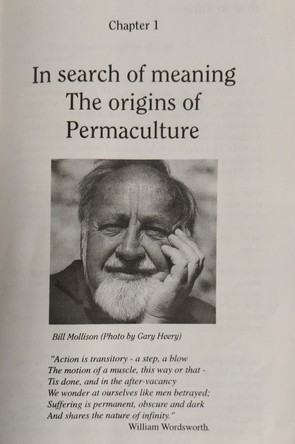Shipping From The USA. Pricing In USD.

Chapter 1
In search of meaning
The origins of
Permaculture
Breaking into Media
It was on May 24 1975, visiting Melbourne, that I was invited by National radio (ABC), to talk on Permaculture on a late programme. Unused to media, I gave my address, and to my horror received thousands of letters. Two things about the letters impressed me; a good 60% were from women who said that they felt it gave them something real to do, and probably 20% said that I had articulated something that they had been struggling to voice. Psychologists call this the ‘Ah-ha’ response; you get it when you express something that people ‘recognise’, that they feel to be right. Permaculture was an idea whose time had come.
We read 600-700 letters, made a list of questions, and sent off photocopies of a summary in 6 parts that David Holmgren and I had written for the early editions of the Organic Gardener and Farmer. Mail alone cost £700, and I was careful to never again give my address. Something like 23 publishers wrote to express interest in a book; and after returning from study leave in the U.K. (1976), I wrote that book, with David contributing, and it became Permaculture One (1978), which was reprinted until 1991, when it was replaced by an updated version, edited by Reny Mia Slay from earlier articles, and essentially a plain-language guide.
David Holmgren had first come to my house aged 17, with a broken arm contracted in a motorbike accident, and no place to stay. He was to study Environmental Design at the TAFE (Technical & Further Education) college on Mt. Nelson; I was a tutor at the University of Tasmania. He was one of the few people I could talk to who wanted to develop the idea of Permaculture in landscape terms, and together we put in a successional garden at my house above Hobart. This was, in the jargon of the times, an ‘open’ house, termed by Benson, ‘The peoples’ republic of 316A Strickland Avenue’. All sorts of people ended up there; alcoholics, Aborigines, victims of incest, students, musicians, fishermen, and party-goers. We estimated that in a lively year, about 300 people came through.From 1972-4 we developed concepts, the garden, and started a library of useful works. In 1975, I bought rural land and built a barn near Margate, intending to live there after study leave in the U.K. My study leave was well used, travelling at first in the U.K. in a Ford Campervan to see what remained of the traditional land systems, and I crossed to Ireland before the Common Market devastated their traditional farming, and just after artificial fertiliser factories made cowshit a waste product. This waste product now contributes methane and ammonia to the air, and is credited with 60% of the nitric acid in rain, and perhaps 13% of greenhouse gases.
Then, a month or two travelling home through peasant Europe, S.W. Asia, and India. Here, I saw persistent people still living in systems thousands of years old. They had, often enough, been robbed of their forests by megalomaniacs (conquerors, newspaper barons, packaging suppliers), but enough remains of traditional cultures to support my belief in the possibility of sustainable systems (including eternal forests). David went to NSW to build a house for his mother, and we saw little of each other thereafter, but both of us continued to work in developing sustainable systems.

